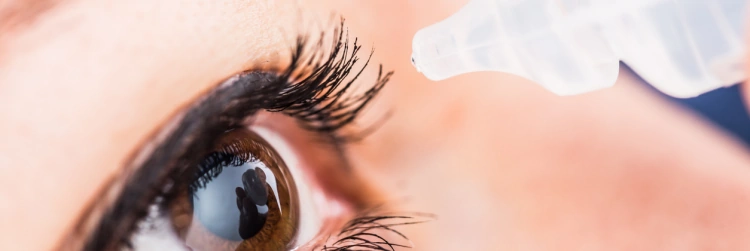What Causes Dry Eyes?
14 May 2019

Approximately, one in every three people over the age of 65 experience symptoms of dry eye syndrome.
Dry eye is a common condition that occurs when the eye is not sufficiently lubricated. This happens when the glands within the eye do not produce enough tears to keep the eye moist.
Although dry eye syndrome is not a cause for concern, it can become very uncomfortable. Some people experience dry eyes due to their environment. Aeroplanes and air conditioned rooms are the biggest culprits for accelerating the symptoms.
The good news is that there are treatments available for the condition. Keep reading to find out what these are; along with the causes and symptoms.
What causes dry eyes?
Dry eyes are caused by the absence of sufficient tears. There are several possible causes of dry eye syndrome, with cases ranging from mild to severe.
Studies have found that, dry eye syndrome is more common in women than men. This is because pregnancy, certain types of birth control and menopause are all factors that contribute to the condition.
The most common causes of dry eyes are:
- Age- people over 50 are more likely to experience dry eyes
- Excessive contact lens use
- Looking at screens for prolonged periods of time
- Air-conditioning
- Windy, cold, dry or dusty environments
- Smoking
- Certain medications, for example some antidepressants or blood pressure drugs
- Conditions such as blepharitis, Sjogren's syndrome or lupus
- Hormonal changes. E.G. taking the Pill, pregnancy or menopause
What are the symptoms of dry eyes?
Symptoms of dry eyes, which affect either one or both eyes, include:
- Itchy eyes
- Sore eyes
- A gritty feeling in the eyes
- Red eyes
- Blurry vision
- Sensitivity to light
- Watery eyes
- Difficulty wearing contact lenses
- Difficulty with night time driving
Is there a treatment for dry eyes?
There are several treatment options available to relieve the symptoms of dry eye syndrome; some of which can be found over the counter. For more severe cases, a doctor may prescribe stronger medication. There are two different ways in which treatment for dry eyes work. Some treatments focus on managing the condition. Whereas other treatments work to improve the quality of tears the eye produces or aims to stop the tears from draining away from the eyes altogether.
Eye Drops/Ointments
Eye drops, or artificial tears as they are sometimes referred, is the most common treatment for dry eye syndrome and is available over the counter. Artificial tears simply work by keeping the eye lubricated. Certain brands of eye drops may contain thickening agents, which keep the solution on the surface of your eye longer. Failing this, an eye ointment can be applied to help lubricate the eye further; but this often causes blurred vision, so is recommended to only be used at night.
Eye inserts
For more severe cases of dry eye syndrome where artificial tears and ointments do not help, eye inserts may be recommended. These are small and look like a clear grain of rice; made up of hydroxypropyl cellulose. Once a day, the insert is placed between the lower eyelid and the eyeball. The insert then gradually dissolves; releasing a substance that lubricates the eye.
Antibiotic tablets
For some, symptoms of dry eye can occur when there is an inflammation along the edge of the eyelids, such as blepharitis, preventing oil glands from secreting oil into tears. In these cases, a doctor may prescribe oral antibiotics to reduce the inflammation.
MiBo Thermoflo
MiBo Thermoflo offers immediate relief for the symptoms of dry eyes. During this affordable treatment, the specialist will apply ultrasound gel to the eye. The upper and lower lids are then gently massaged using a MiBo eye pad; which is heated to a comfortable temperature.
The heated pad is needed to encourage the glands around the eyes to produce more oil, almost always immediately and with no side effects. The treatment itself is actually a very comfortable and relaxing experience.
This procedure lasts on average 12 minutes per eye, but can vary. The specialist will recommend the amount of treatments required.
Contact lens wearers will be able to continue with use straight after treatment.
Currently Ultralase do not offer MiBo Thermoflo treatment.
Back to Blog
